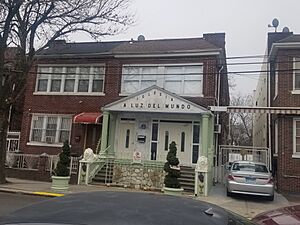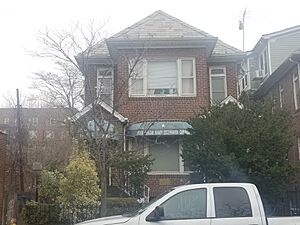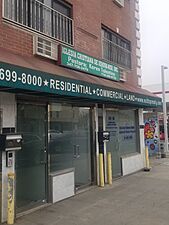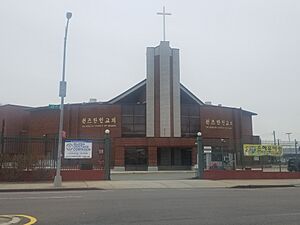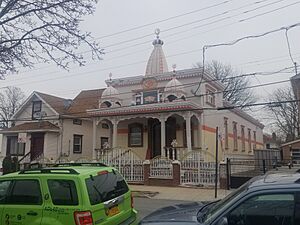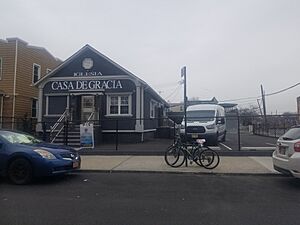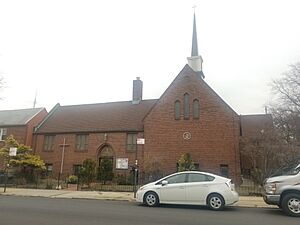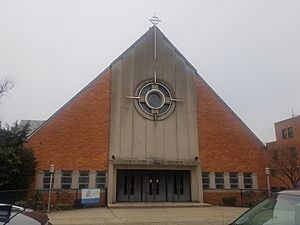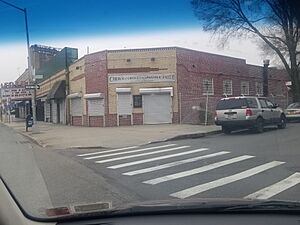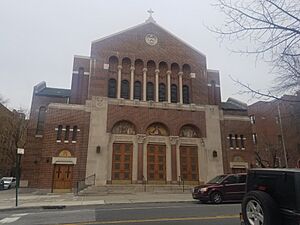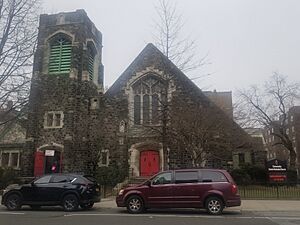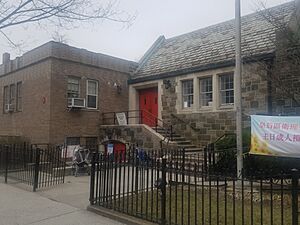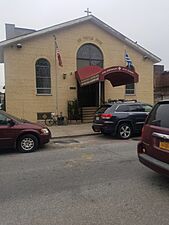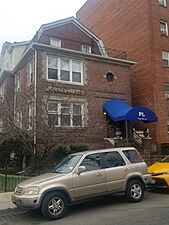Jackson Heights, Queens facts for kids
Quick facts for kids
Jackson Heights
|
|
|---|---|
|
Neighborhood of Queens
|
|

Little India on 74th Street in Jackson Heights
|
|
| Country | |
| State | |
| City | New York City |
| Borough | Queens |
| Community District | Queens 3 |
| Population
(2010)
|
|
| • Total | 108,152 |
| Ethnicity | |
| • Hispanic | 56.5% |
| • Asian | 22.0 |
| • White | 17.2 |
| • Black | 2.0 |
| • Other/Multiracial | 2.3 |
| Time zone | UTC−5 (EST) |
| • Summer (DST) | UTC−4 (EDT) |
| ZIP Code |
11372 (primary) & 11370 (though often regarded more as part of East Elmhurst)
|
| Area codes | 718, 347, 929, and 917 |
| Website | [ link broken ] |
Jackson Heights is a lively neighborhood in the northwestern part of Queens, one of New York City's five boroughs. It's known for being incredibly diverse, with people from all over the world calling it home. In fact, The New York Times once called it "the most culturally diverse neighborhood in New York, if not on the planet."
This area was once a large marsh called Trains Meadow. In 1909, a company called the Queensboro Corporation bought a lot of this undeveloped land. They named it Jackson Heights after Jackson Avenue, which was named after a respected local businessman, John C. Jackson. The Queensboro Corporation wanted to create a special community with "garden apartments," which are apartments built around green spaces.
Over time, Jackson Heights grew, especially with new transportation options like the subway. In the 1960s, more diverse groups of people began moving into the neighborhood. Today, Jackson Heights is mostly residential, meaning many people live there. It also has many shops and restaurants, especially near its subway stations. A large part of the original planned community is now a protected historic district, recognized for its unique architecture and design.
Jackson Heights is part of Queens Community District 3. Its main ZIP Code is 11372. The neighborhood is looked after by the New York City Police Department's 115th Precinct.
Contents
- Exploring Jackson Heights' Past
- What Jackson Heights Looks Like Today
- Who Lives in Jackson Heights?
- Community Life
- Economy in Jackson Heights
- Parks and Fun Places
- Safety and Services
- Learning and Education
- Places of Worship
- Getting Around Jackson Heights
- Famous People from Jackson Heights
- Jackson Heights in Movies and TV
- See also
Exploring Jackson Heights' Past
How Jackson Heights Got Its Name
The name Jackson Heights comes from Jackson Avenue, which is now mostly known as Northern Boulevard. This important road cuts through the neighborhood. John C. Jackson, a local entrepreneur, built the road in 1859. The "Heights" part of the name was used to suggest it would be an exclusive, fancy place, even though the land wasn't particularly high. Before 1916, the area was called "Trains Meadow." This name might have come from a word meaning "drain," as there weren't many trains there at first.
Early Growth and Transportation
The Queensboro Corporation started buying land in Jackson Heights in 1910. By 1914, they owned about 325 acres. At first, getting to the area was hard, mainly by ferry or bridge from Manhattan. But things changed quickly! The Queensboro Bridge opened in 1909, making travel easier. Then, in 1917, the elevated IRT Flushing Line subway (today's 7 train train) arrived, making it only a 20-minute ride from Manhattan. Double-decker buses also started running in 1922.
Building a Unique Community
Jackson Heights was carefully planned by the Queensboro Corporation starting around 1916. People began moving in after the subway arrived in 1917. The goal was to create a nice place for middle- to upper-middle-income families from Manhattan to live and raise children.
The Queensboro Corporation came up with the idea of "garden apartments." These were apartment buildings designed around beautiful green spaces and private parks. This made Jackson Heights the first "garden city" community in the United States. Many of these buildings are still standing today, typically five or six stories tall. They were built with nice features like fireplaces, wooden floors, and sun rooms. The corporation also made sure there were streets, sidewalks, and utilities like water and power.
Important Early Buildings
The Laurel apartment building, finished in 1914, was the first Queensboro Corporation building in Jackson Heights. It had a small courtyard. The Greystones, built in 1918, were designed by architect George H. Wells.
In 1919, the Linden Court complex was built. It had 10 buildings with a shared garden and even parking spaces with garages. This was a new idea for the area! These buildings were designed to let in lots of light and air, and they helped create a strong sense of community.
Later, in the 1920s, other famous buildings like the Hampton Gardens, the Château, and the Towers were built. The Château, for example, had a beautiful French Renaissance style with special roofs and brick walls. These newer buildings often had paved areas in their shared gardens where people could gather.
Advertising the Dream
The Queensboro Corporation was very good at advertising. In 1922, they even paid a radio station to broadcast a ten-minute sales pitch for their apartments. This might have been one of the very first "infomercials"!
In 1928, the English Gables buildings were constructed on 82nd Street. They were designed to welcome people coming into the neighborhood, especially from the subway station. A year later, the Robert Morris Apartments were built, known for their green spaces and high ceilings.
Changes Over Time
During the Great Depression, apartments in Jackson Heights became more affordable. New buildings like Ravenna Court (1929) and Georgian Court (1930) were added. The Queensboro Corporation also started building on land that used to be open spaces, like tennis courts and a golf course.
By 1930, Jackson Heights had grown a lot, from 3,800 residents in 1910 to about 44,500. The community was very close-knit. Over time, the neighborhood became more welcoming to different groups of people. By the 1960s, many new immigrants started moving to Jackson Heights, making it even more diverse.
Protecting Jackson Heights' History
Most of the original garden city apartment buildings in Jackson Heights are now part of a special Jackson Heights Historic District. This means they are protected because of their historical importance. The district includes over 2,200 buildings and was added to the National Register of Historic Places in 1999.
About half of the neighborhood was also named a New York City Historic District in 1993. This local protection helps keep the unique look and feel of the buildings and gardens.
What Jackson Heights Looks Like Today
Shopping and Food
Jackson Heights has many shops and restaurants. The main shopping street is 37th Avenue. You'll also find lots of stores on 73rd, 74th, and 82nd streets.
A Taste of the World
On and near 74th Street, you'll find many businesses that serve the large population from the Indian subcontinent. There are shops selling beautiful saris, jewelry, and music. You can also find many delicious Indian and Bengali restaurants.
37th Avenue has a wide variety of shops, including many grocery stores. 82nd Street has many well-known chain stores in charming Tudor-style buildings. If you go to Northern Boulevard, especially east of 80th Street, you'll find many South American shops and eateries, mainly from Colombia and Peru. Roosevelt Avenue also has many Hispanic stores.
Street Food Adventures
Along Roosevelt Avenue, from 74th to 108th Streets, you can find amazing street food from all over the world! Food carts offer tasty treats like Bengali fuchka, Middle Eastern lamb over rice, Nepalese momo, Colombian chuzos and arepas, Greek souvlaki, Ecuadorian ceviche, Thai chicken and rice, and Mexican elotes (corn on the cob), tacos, and tamales. You can also get fresh fruit smoothies (batidos) and sweet churros.
Famous chef Anthony Bourdain even visited Jackson Heights for his show Parts Unknown. He highlighted a Mexican immigrant named Evelia Coyotzi, who sells delicious tamales from her street cart.
Other Buildings and Theaters
Most homes in Jackson Heights are apartments in multi-story buildings. Many of these are "co-ops," where residents own a share of the building. There are also some one- to three-family houses, often attached row houses.
Jackson Heights once had five historic movie theaters. Today, they have either been used for other purposes or closed. For example, the Colony Theater closed in 1991, and the Jackson Heights Cinema was taken down in 2017. The Boulevard Theater is now a Latin-American restaurant.
Who Lives in Jackson Heights?
Jackson Heights is home to about 108,152 people, based on the 2010 United States Census. It's a very diverse place! More than half of the people living here are of Hispanic background. Many people are also of Asian, White, and Black backgrounds.
The neighborhood has a good mix of ages, with many middle-aged adults and young people. Most people in Jackson Heights are working hard, and the community is considered to have a good income level compared to other parts of New York City.
Jackson Heights is known for being one of the most diverse neighborhoods in the entire country. About half of its residents were born outside the United States. It has large communities of people from South America (like Colombia, Ecuador, and Argentina) and South Asia (like Bangladesh, Pakistan, Tibet, Nepal, and India). Because of its large Tibetan community, some even call it "the second capital of the exile Tibetan world" after Dharamsala, India.
You can find a "Little India" on 74th Street and "Little Pakistan" and "Little Bangladesh" on 73rd Street. East of 77th Street, there's a big concentration of South Americans, with a "Little Colombia" along 37th Avenue.
The word game Scrabble was co-invented by Alfred Mosher Butts, who lived in Jackson Heights. There's even a special street sign at 35th Avenue and 81st Street that looks like Scrabble tiles!
Community Life
Local Groups and Events
The Jackson Heights Garden City Society is a group that helps preserve the history of the neighborhood. They have a walking guidebook and collect old items from the community. The 82nd Street Partnership works to improve businesses in the area.
You can also find a year-round farmers' market every Sunday morning at Travers Park. There are also concerts for families in the spring and summer.
The LGBTQ Community
Jackson Heights has a large and active LGBTQ (Lesbian, Gay, Bisexual, Transgender, Queer) community. In the 1920s, many LGBTQ actors from Broadway theaters moved to Jackson Heights because it was more affordable and easy to reach by subway. This was the start of what is now the second largest gay community in New York City.
In 1993, the first Queens Lesbian and Gay Parade and Block Party Festival took place in Jackson Heights. This was a very important event for LGBTQ history in the area. Thousands of people participated and watched. Since then, the LGBTQ community in Jackson Heights has continued to grow and become even more diverse.
Economy in Jackson Heights
Between 2009 and 2018, Jackson Heights saw a big increase in its economy. The amount of money businesses made grew by 72% during this time. By 2018, there were about 3,300 businesses in the neighborhood, which was a 25% increase from 2009. This shows that Jackson Heights is a thriving place for businesses.
Parks and Fun Places
Travers Park is the main local park in Jackson Heights. It used to have many sports fields for basketball, tennis, baseball, soccer, and handball. Recent renovations in 2020 changed some of these areas into lawns and seating spaces.
The schoolyard at P.S. 69 also used to have sports fields and tennis courts that the public could use. In 2011, it was reopened as a public playground as part of a city program to make sure everyone lives close to a park.
Safety and Services
Fire Safety
Jackson Heights is protected by two New York City Fire Department (FDNY) fire stations. One is Engine Co. 307/Ladder Co. 154 on Northern Boulevard, and the other is Engine Co. 316 on Kearney Street.
Mail Services
Jackson Heights is covered by several ZIP Codes, mainly 11372. The United States Post Office has three locations in the neighborhood: Jackson Heights Station, Junction Boulevard Station, and Trainsmeadow Station.
Learning and Education
Jackson Heights has a good education system. While some residents have college degrees, many are high school graduates. The percentage of students doing well in math and reading has improved over the years.
Schools in the Neighborhood
The New York City Department of Education runs public schools in Jackson Heights. Some of these include P.S. 69 Jackson Heights School, P.S. 149 Christa McAuliffe School, P.S. 212, and I.S. 145 Joseph Pulitzer School.
There are also charter schools like the Renaissance Charter School, and private schools such as Saint Joan of Arc School, Our Lady of Fatima School, and Garden School.
Library
The Queens Public Library has a branch in Jackson Heights located at 35–51 81st Street.
Places of Worship
Jackson Heights is home to many different churches, temples, and centers for various religions, showing its diverse community.
The Community United Methodist Church, founded in 1919, is the oldest church in Jackson Heights. It now offers services in Chinese, Korean, Spanish, and English, reflecting the neighborhood's diversity.
Satya Narayan Mandir is a Hindu-Sikhism temple, believed to be the oldest of its kind in the United States. Saint Joan of Arc Catholic Church was the first Catholic church named after the newly recognized French Saint. The Muhammadi Community Center serves the Muslim community. St. Mark's Episcopal Church also offers bilingual worship.
Getting Around Jackson Heights
Public Transportation Options
Jackson Heights is well-connected by New York City Subway lines. You can use the Jackson Heights–Roosevelt Avenue/74th Street station, which is a major transportation hub. Other subway stations include 82nd Street–Jackson Heights, 90th Street–Elmhurst Avenue, and Junction Boulevard. All of these are served by the 7 train train.
Many MTA Regional Bus Operations bus routes also serve Jackson Heights, including the Q29, Q32, Q33, Q47, Q49, Q53 SBS, Q66, Q70 SBS, and Q72. The Jackson Heights–Roosevelt Avenue/74th Street station is a big hub where several subway lines and buses meet. It even has a "green building" bus terminal that uses solar panels!
Major Roads and Bike Lanes
Important roads in the area include Interstate 278 (Brooklyn Queens Expressway), New York State Route 25A (Northern Boulevard), and the Grand Central Parkway. LaGuardia Airport is also very close by.
Jackson Heights has bike lanes on about 11% of its roads, similar to the rest of New York City. You can find these lanes on 34th Avenue, and on 74th and 75th streets.
Famous People from Jackson Heights
Many notable people have lived in Jackson Heights over the years. Here are just a few:
- Nadia Ali (born 1980), a singer-songwriter.
- Alfred Mosher Butts (1899–1993), who invented the game Scrabble.
- Chester Carlson (1906–1968), who invented the Xerox copy machine.
- Charlie Chaplin (1899–1977), a famous silent film actor.
- Montgomery Clift (1920–1966), a well-known actor.
- Lucy Liu (born 1968), a popular actress.
- Victor Moore (1876–1962), a Broadway and film actor.
- Les Paul (1915–2009), a famous jazz guitarist and inventor.
- Don Rickles (1926–2017), a comedian.
- Susan Sarandon (born 1946), an Academy Award-winning actress.
- Gene Simmons (born 1949), from the rock band Kiss.
- Howard Stern (born 1954), a famous radio host.
Jackson Heights in Movies and TV
Jackson Heights has been featured in many movies and TV shows:
- The Alfred Hitchcock film The Wrong Man (1956) takes place near Broadway and 74th Street.
- The TV show Car 54 Where Are You? (1961–63) mentions Jackson Heights in its theme song.
- In Coming to America (1988), a character is called "Jackson Heights' own."
- Parts of The Usual Suspects (1995) were filmed in Jackson Heights.
- The Academy Award-nominated movie Maria Full of Grace (2004) was filmed there.
- It's the setting for the TV show Ugly Betty (2006–10).
- The documentary film In Jackson Heights explores the neighborhood's diversity.
See also
 In Spanish: Jackson Heights (Queens) para niños
In Spanish: Jackson Heights (Queens) para niños


